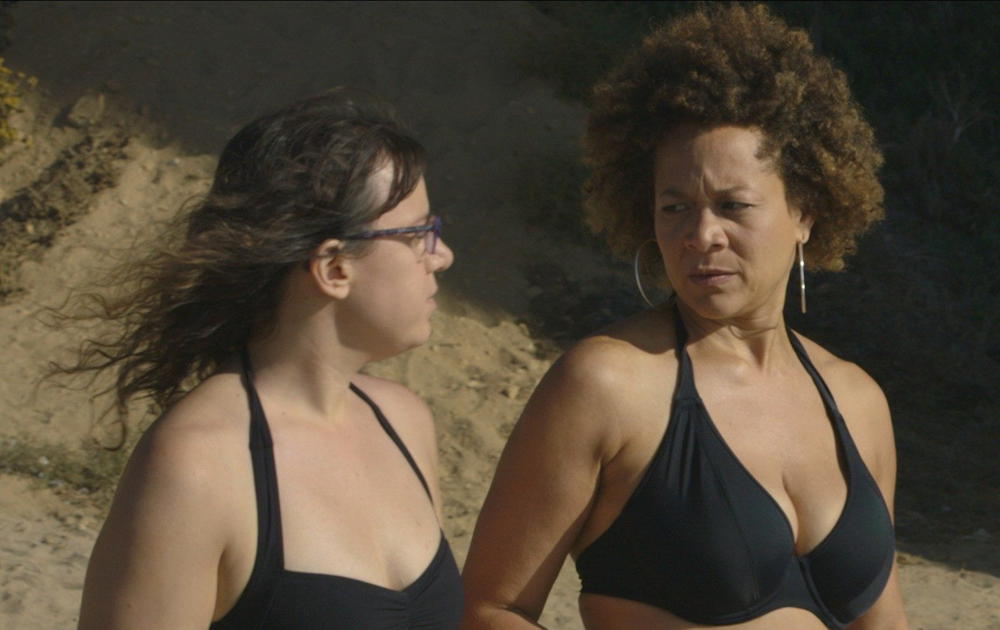When Joanna Arnow was location scouting for her latest short “Laying Out,” the New Yorker decided to come out to the west coast to film the biting sand-set satire, setting her sights on Point Dume.
“Actually, there was a pirate’s cove area that was harder to get to [than where we shot] and I was like, “This is the place. We must shoot here!” says Arnow, who was quickly brought back down to earth by her producer who assured her it just wasn’t feasible on their schedule.
Still, Arnow is able to go where few others would dare with “Laying Out,” which will no doubt amuse and delight those who caught her previous films “i hate myself :)” and “Bad at Dancing,” but feels like a slight departure as it removes the burden off the filmmaker from revealing the most intimate details of her private life, at least directly, and adds her witty insights to the tale of two mermaids that have been stranded on the shore. Instead of a variation on herself, Arnow casts herself as confidant and amateur therapist to a fellow mythological creature (Michole Briana White) whose concerns lean towards her human side, deeply upset about an act of aggression in an otherwise comfortable relationship with her male partner and wishing she had a penis and the privilege that would come with it. The scenario is outrageous in any number of ways, but Arnow cleverly positions the fantasy of desiring one form of genitalia against the sight of fantastical characters that have long held a place in the popular imagination as objects of desire, either amongst men who have fetishized the clamshell-bra clad creatures or women who have grown up seeing them as a symbol of liberation with the expanse of the ocean to navigate in, only to reconsider upon thinking some parts are holding them back.
Naturally, this is not your usual day at the beach and Arnow mines this contradiction, among others, for all it’s worth, creating a five-minute two-hander that may appear simple on the surface, but soon becomes a sharp reflection on ingrained beliefs about gender roles and the difficulty to break free of them. With the film premiering this weekend at the New York Film Festival as part of its New York Stories shorts program, the filmmaker spoke about the ideas behind her latest work, why setting a production near the water is hardly a vacation and how the natural rhythms of the environment contributed to the performances.
How did this one come about?
The [idea for the recurring] line about “Keep doing that and you’ll get your dinner” has been in my head for a while actually, and I was excited about it and it seemed to naturally progress to this conversation about gender roles and sexual identity and internalized misogyny that all relayed back to this lack of dinner. Then I wrote this piece with the beach as a starting point, forgetting how terrible it is to make a film on a beach. [laughs] But this is the story that unfolded. I was interested in the move towards openness as two women start seated and then that move to the shore, and staging the action around the shoreline [where] there was this suggestion of being at the border of two places, dancing between them without clear resolution.
Did you immediately think these ladies should be mermaids?
I wanted it to be open for interpretation, but I saw the mermaid tales as being loosely reflecting the constraints of gender norms. One of my favorite discussions during the pre-production process was with the costume designer Sofie Somoroff and the production designer Zoe Koke about how uncomfortable the tails should appear because we wanted to show the constraints of the characters are wrestling with, but at the same time, we wanted them to be able to walk and not to leave them without agency, so as these two women dancing around these questions around sexuality and gender roles on the shoreline, there’d be this suggestion of mermaids as people caught between two places as well, not fully at home in either. Also, it was meant as a funny and absurd counterpoint to the dialogue that’s happening.
The film is as provocative as anything you’ve done, but notably this seems different in how you don’t have to put yourself out there as much as in previous films where you seemed to blur the lines of reality and fiction. Did it feel different for you?
Yeah, I was interested in playing a role that wasn’t the confessional protagonist since I’ve done that before and wanted to experiment with cross-casting. I thought there was more tension in that, going in a different direction, although the role that I did play I wrote with myself in mind and I drew from personal experience in writing this [based on] wrestling with contradictions about internalized misogyny and gender roles and sexual identity, hoping that it would relate to others in portraying this character.
How did you find your wonderful co-star for this?
[Michole] was someone I had met once briefly and when I was casting this, I had looked into her work and thought she would be great for the role. We rehearsed a couple of times before the film shoot and the relationship between these characters is very specific and not completely out of the realm of reality, but it’s a heightened and absurd relationship, so it was exciting to explore different options with her in the rehearsal process. She’s also a singer and one thing that really excited me about her was the musicality of her voice, which I thought would work when this film was dialogue-driven.What was it like to get out to the beach?
The beach was challenging. There was like props flying away, the tide coming in, rock climbers coming into our background and of course, the film only works because of our amazing sound recordist Kara Johnson and [while it was] hard to work with an uncontrolled environment and changing light, it was exciting. I feel like the not doing the film MOS [sound that’s not synched] and actually including those natural rhythms of the ocean was very important to me because I feel like it affected the dialogue and where our characters were taking pauses, even subconsciously. I really liked having all these dynamics in a piece that is so dialogue-driven — it gives it some shape and punctuation, and seeing dolphins and birds pop up in the background unexpectedly was a real present. [laughs]
This is a silly final question, but what on earth were you drinking in the film?
[laughs] They are smoothies. Honestly, they were supposed to be pina coladas, but I ended up liking them more as they are — how their brown color blends into the rock background and how they feel slightly off. They might be health-conscious protein shakes, but then they have these umbrellas in them, it felt like that tension and off-ness is in line with the themes of the film and the drinks were important to me because I felt it was helpful to start building the awareness of absurd elements in the offscreen space to set the stage for the mermaid tail reveal. The world keeps expanding outward from the first initial claustrophobic shot and then the introduction of the drink is the first step in that direction outwards.“Laying Out” will premiere at the New York Film Festival as part of New York Stories at the Walter Reade Theater on October 6th at 8:30 pm and October 10th at 6:15 pm.




